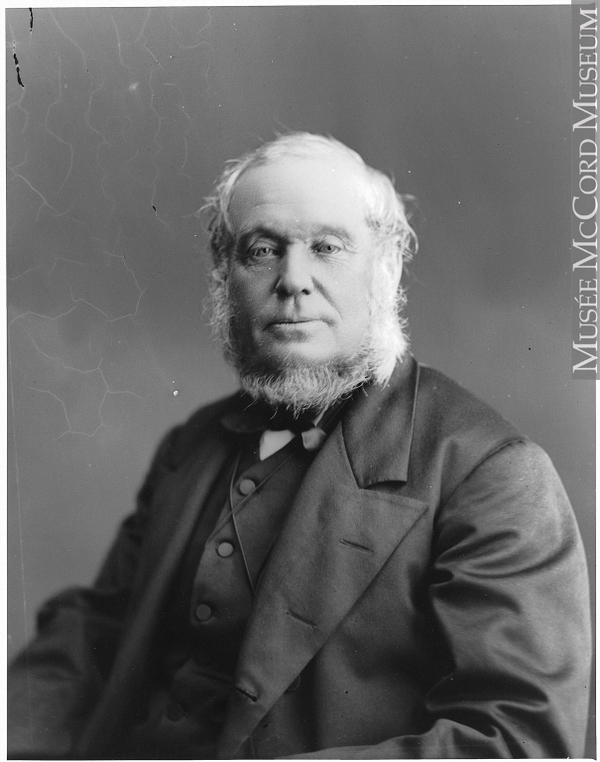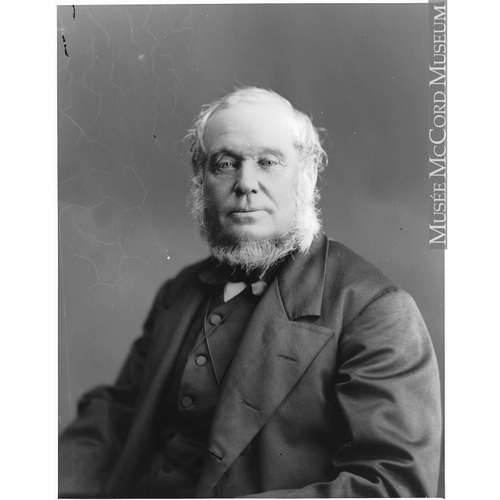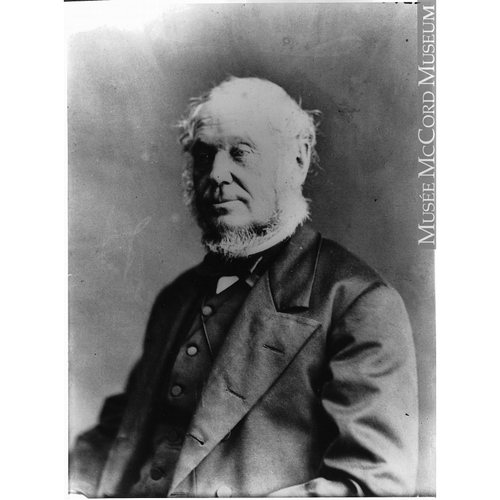
Source: Link
SMALLWOOD, CHARLES, physician, professor of meteorology, and founder of McGill Observatory at Montreal; b. 1812 in Birmingham, Eng.; d. 22 Dec. 1873 in Montreal, Que.
Charles Smallwood arrived in Canada in 1833, with an md from University College, London, and for at least two years lived at Huntingdon, Lower Canada. There he kept a weather notebook. He was licensed to practise medicine in Lower Canada on 16 July 1834. Sometime between late 1835 and early 1841 he established a residence and presumably a medical practice at Saint-Martin (Isle-Jésus), nine miles west of Montreal.
For the years until 1856 information about Smallwood is meagre. However, a paper published by Smallwood in 1858 describes, as it was then, the weather observatory he had established at Saint-Martin in 1841, and had developed since that time. It was a small wooden building, within 20 yards of his house, with instruments inside, outside, and on an array of wooden masts. Regular instruments included barometers, thermometers, hygrometers, an anemometer, and rain and snow gauges. He took readings of these and recorded observations of the state of the sky three times daily, along with notes on natural events such as bird migrations. He built ingenious autographic recorders, some of them photographic. Dew and evaporation were measured. Ozone, measured by chemically prepared paper, was studied intensively. A copper lantern, hoisted to the top of an 80-foot mast, was connected to electroscopes and electrometers, to measure atmospheric electricity. Snow crystals were examined by microscope and by photography. With a 7-inch telescope he took astronomical observations on all favourable nights. For time-keeping, a transit telescope looked out through an opening along the ridge of the roof, and the observatory was connected by the Montreal telegraph with major cities in the United States.
After 1856 information about Smallwood’s activities suddenly becomes plentiful. In that year a committee of the Montreal Natural History Society visited his observatory and subsequently forwarded a petition to parliament urging assistance for publication of his records for the preceding 15 years. When the American Association for the Advancement of Science met in Montreal in 1857, Smallwood gave the opening remarks and they are those of someone who is clearly an established member of the Montreal scientific community.
He had been elected an honorary member of the Montreal Natural History Society in 1856, and was president in 1865. His papers were usually presented to that society. Six papers and four annual weather reviews appeared in the Canadian Naturalist (conducted by a committee of the society) in 1857–60, nine papers and seven weather reviews in 1866–72. Perhaps his most important paper, “On some of the forms of snow crystals and the different electrical states of the atmosphere during their formation,” appeared in the annual report of the society for 1855–56. The topic to which he gave most attention was ozone, especially its relation to relative humidity rather than to atmospheric electricity. Smallwood’s scientific activities also brought him in 1856 an lld from McGill University and he was appointed professor of meteorology, without salary. (A further degree of dcl was granted by the University of Bishop’s College in 1864.)
In 1863 all the apparatus of Smallwood’s observatory was moved from the frame building at Saint-Martin to a stone structure built for the purpose in the McGill University grounds. The Montreal Observatory, as the establishment was renamed (later McGill College Observatory, then the McGill Observatory), remained in this building until it was demolished in 1962, and continues now in the Macdonald Physics Building. (Dr Smallwood had moved his own residence and practice, probably in 1863 but surely by 1868, to Montreal.) Magnetic-field observations were added by the observatory. The astronomical time-keeping was made available to the community; it was only succeeded as a national time service by the Dominion Observatory at Ottawa in the 1920s, and like the weather recording its time-keeping has continued to this day.
For almost six years, commencing in January 1857 and terminating with Dr Smallwood’s removal to Montreal, the Canadian Naturalist published monthly tabulations of the Saint-Martin observations. It published others for the McGill Observatory, but only for ten months of 1864. These “abstracts” are the only detailed record of Dr Smallwood’s observations, apart from record books at the McGill Observatory for 1860–62 (Saint-Martin) and 1868–72 (McGill).
Dr Smallwood had had various grants for his meteorological work but had canvassed over some 15 years for comprehensive government support for the observatory. It was finally obtained in 1871, jointly from. the Signal Office of the United States War Department and the Canadian Ministry of Marine and Fisheries. The observatory became the Montreal station in the network reporting observations directly by telegraph to Toronto for use in national weather forecasting by the Meteorological Service of Canada, established in 1871.
Also in the spring of 1871, Bishop’s College created in Montreal a medical faculty, toward which Dr Smallwood had been a prime mover. On 19 March he became professor of midwifery and diseases of women and children; next day the new faculty met and elected him their dean. In late May, however, he finally received word of government support for the observatory and resigned his medical positions; on 12 June the medical faculty met, but failed to dissuade him.
Just two years later, in December 1873, Dr Smallwood died after a brief illness, and was buried on Christmas Eve. He was succeeded at the observatory by his assistant, Clement Henry McLeod.
Smallwood was a member of four foreign scientific societies: La Société Météorologique de France, the Pulkova astronomical observatory, Académie Royale de Belgique, the National Institute of the United States, and the Academy of Natural Sciences (Philadelphia). He was a governor of the College of Physicians and Surgeons of Lower Canada (founded 1847) from 1851 until at least 1865. His achievements as meteorologist become more striking when they are recognized as being an avocation, carried out while he was practising medicine, with sufficient competence to be offered a medical professorship.
Charles Smallwood’s research and studies have been published by the Natural History Society of Montreal in: Canadian Naturalist and Geologist (Montreal), II (1857), 321–35; III (1858), 110–15, 352–61, 444–49; IV (1859), 81–84, 169–72, 276–80, 343–45, 383–87, 408–10; new ser., III (1868), 125–34; Canadian Naturalist and Quarterly Journal of Science (Montreal), new ser., IV (1869), 62–64, 112–18, 183–87, 249–56; new ser. V (1870), 10–13, 22–23; new ser., VI (1872), 334–39.
PAC, RG 1, E1, 82, p.497; RG 4, C1, 247, no.549; 393, no.149; 408, no.627; 494, no.478; 511, no.717; 512, no.805; 522, no.2231; 570, no.138; 588, no.272; 760, no.2989; 768, no.1351; 794, no.191; 796, no.58; 798, no.232; RG 19, D4a, 4, 16 March 1861. McGill Observatory (Montreal), Charles Smallwood’s record book, Montreal Observatory, 1868–72; Charles Smallwood’s record book, Saint-Martin, 1860–62. Natural History Society of Montreal, Annual Reports, 1854–81.
Cite This Article
J. S. Marshall, “SMALLWOOD, CHARLES,” in Dictionary of Canadian Biography, vol. 10, University of Toronto/Université Laval, 2003–, accessed January 20, 2026, https://www.biographi.ca/en/bio/smallwood_charles_10E.html.
The citation above shows the format for footnotes and endnotes according to the Chicago manual of style (16th edition). Information to be used in other citation formats:
| Permalink: | https://www.biographi.ca/en/bio/smallwood_charles_10E.html |
| Author of Article: | J. S. Marshall |
| Title of Article: | SMALLWOOD, CHARLES |
| Publication Name: | Dictionary of Canadian Biography, vol. 10 |
| Publisher: | University of Toronto/Université Laval |
| Year of publication: | 1972 |
| Year of revision: | 1972 |
| Access Date: | January 20, 2026 |




